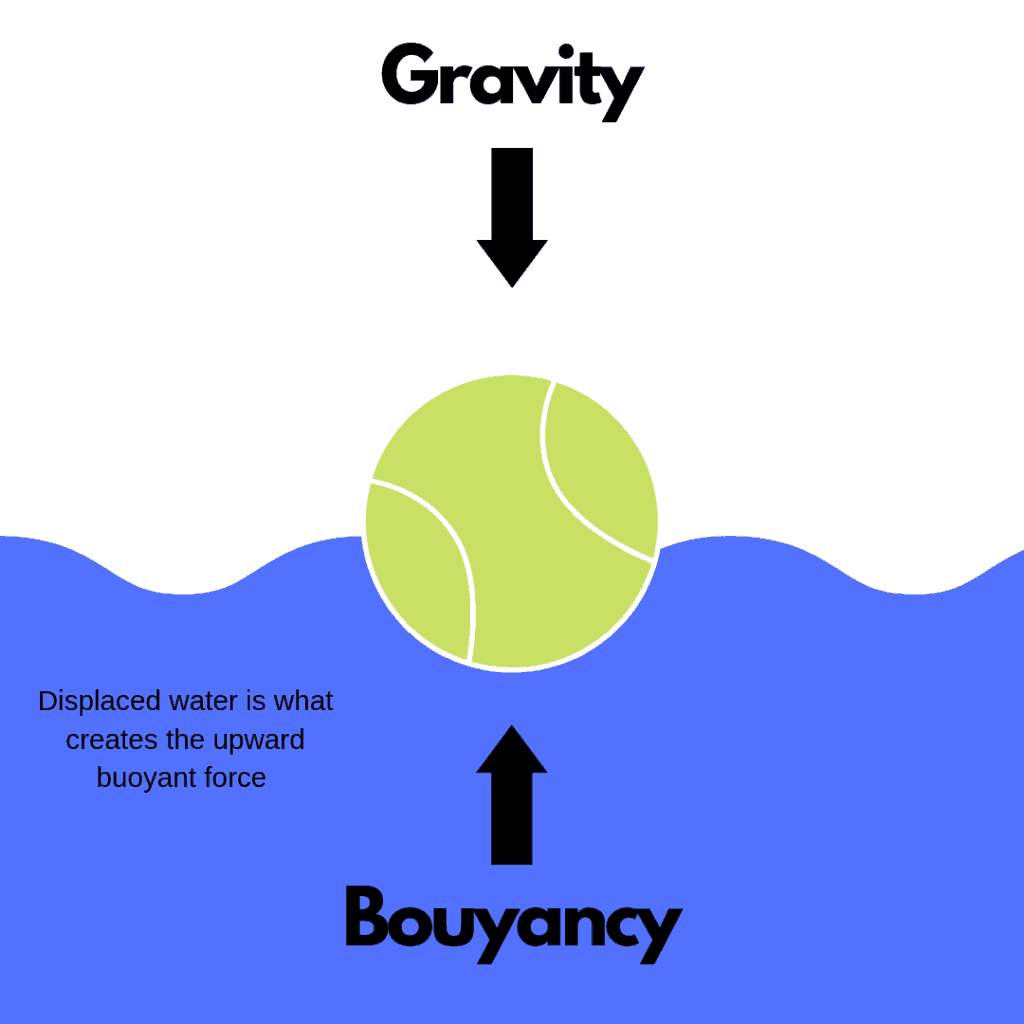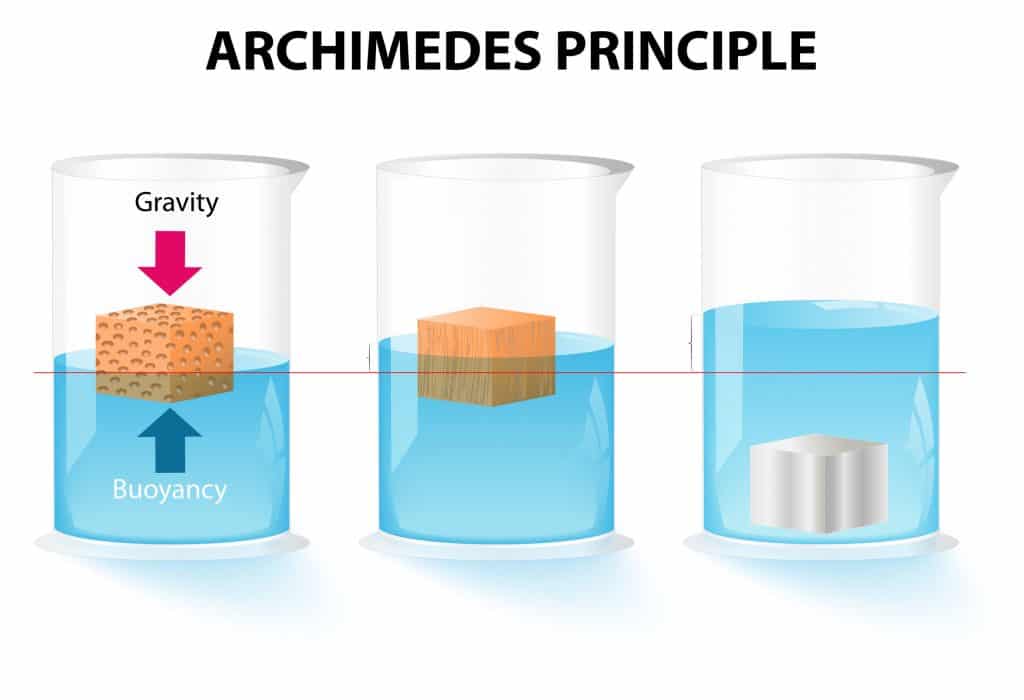
Have you ever seen large, colorful balloons soar above the clouds and wondered how they got there? If so, you’re not alone!
Hot air balloons can achieve flight because of the law of buoyancy, also called Archimedes’ principle. Archimedes’ principle states that an object in fluid (gas or liquid) is acted upon by an upward force equal to the fluid displaced by the object. Since hot air is lighter than normal air, the balloon is buoyant.
To the uninitiated, that may be a little confusing. Below, we’ll discuss all the ins and outs (and the ups and downs) of buoyancy!
What is Buoyancy?
In the simplest terms, buoyancy is the upward force on an object at rest in a fluid. The easiest way to think about this is to imagine a tennis ball placed in a pool.
Example 1
When the tennis ball is placed in water, you’ll notice that it sinks a little bit. However, the tennis ball will never be completely submerged by the water. That is because the force pushing upwards on the tennis ball, the buoyant force, is greater than the mass of the tennis ball.
That buoyant force is created by the fluid displaced by the tennis ball. Remember how the ball sinks a little bit into the water? That displaces water until the force of the water displaced equals the force exerted by the tennis ball.
That might be a lot of words if you’re a visual learner. This will help:

Example 2
Now imagine for a second that instead of a tennis ball, you dropped a ball of led into the pool. This ball of lead is the exact same size as the tennis ball, but obviously weighs much more.
As you can imagine, the ball of led would sink right to the bottom of the pool. Why is this?
The led ball displaces as much water as the tennis ball, but it weighs much more. Because of this, the upward force of the dispersed water will never equal the downward force of the led ball.
This causes the led ball to sink.
The following diagram will compare what happens to objects of the same size but different weight in water. This mimics exactly what we just discussed with the tennis ball and the led ball.

This law of buoyancy is what causes boats to float and hot air balloons to fly. The next time you go on a cruise or jump in a hot air balloon, you can envision this law at work!
Who Discovered Buoyancy?
We’ve all had great ideas while sitting in the bath tub or shower. There’s something about relaxing in water that gets the brain juices flowing!
Well, this is exactly what happened to a Greek mathematician named Archimedes.
Archimedes is one of the greatest minds of the old world. He is responsible for numerous discoveries in mathematics, physics, engineering, and astronomy! He is also a great inventor!
The law of buoyancy was one of his greatest discoveries, and it comes with a great story!
The Golden Crown
There’s an ancient tale that explains how Archimedes discovered buoyancy. Some of it is definitely true, but there’s some that may be fabricated. I’ll let you be the judge.
Archimedes lived in Syracuse, a province of modern day Italy. The king of Syracuse at the time was a man by the name of King Hiero II.
King Hiero II had commissioned the creation of a golden crown to be placed in the temple at Syracuse. This crown was to be shaped like a laurel wreath. King Hiero II provided a lump of gold to a local goldsmith for the creation of the crown.
When the king received the crown, he was impressed by it’s craftsmanship and beauty. However, there were some who claimed that the goldsmith used some silver in the design to make the crown light enough.
Archimedes was brought in to discover the truth. The king did not want Archimedes to damage the crown in any way, so Archimedes had to get creative.
The story goes that as Archimedes got into his tub to think over the problem, he observed water spilling over the side of the bath as he lowered himself in. In a moment, he had his answer!
Archimedes was so excited he ran all the way home naked! The streets of Syracuse filled with his shouts of “Eureka! Eureka!”.
The test was simple: Archimedes would place the crown and a lump of gold identical to the first in a tub of water. If they had the same volume, they would displace the same amount of water no matter the shape.
If silver had been added, the volume would be different and the crown would displace water.
The dishonest goldsmith was exposed, and the law of buoyancy was discovered!

Buoyancy and Balloons
So how does Archimedes’ principle apply to hot air balloons?
The first thing to remember is that a fluid is a liquid or a gas. All the examples above utilized liquids, but the same laws apply to gases because they’re fluids too.
The air all around us counts as a gas, and it’s the state of matter that hot air balloons use to rise!
Like the name implies, hot air balloons achieve flight because of hot air. As the air inside the balloon (or the envelope) heats up, it becomes less dense than the air outside the envelope. This causes the balloon to rise.
The Balloon vs the Balls
Remember our example of the tennis ball and the led ball? A hot air balloon is a lot like that.
Before the air in the envelope is heated, it is just as dense as the air outside the envelope. This is like the led ball. The size of the balloon is exactly the same as a balloon that is flying, but the weight of the air inside the balloon is greater than the air it is displacing.
When the air inside the balloon is heated, the gas inside becomes less dense. In other words, the gas weighs less even though the size of the envelope remains the same.
When this happens, the balloon lifts because it weighs less than the air it is displacing. This means the upward force on the balloon is equal to, and then greater than the weight of the balloon.
Holey Buoyancy!
A hot air balloon has two holes: one at the bottom and one at the top. The hole at the bottom, often called the throat, lets the hot air into the balloon. The hole at the top, or the parachute valve, lets hot air out of the balloon when opened.
To keep a hot air balloon in the air, the air in the envelope needs to be heated consistently. This keeps the envelope buoyant.
If you want to land a hot air balloon, you can let hot air out. As the balloon becomes less and less buoyant, it will begin to fall. You can also choose to let the air in the balloon just cool naturally, but this means you have much less control over the descent.
Buoyancy in Practice
So how do you actually apply these principles in a hot air balloon?
We’ve already discussed some of the parts of a hot air balloon, but here’s a quick review that will help you understand how to apply Archimedes principle:
| Part | What it Does |
| Basket | The box at the bottom of a hot air balloon that holds cargo. |
| Envelope | The “balloon” that gets filled with air. |
| Skirt | A nonflammable cloth at the bottom of the envelope around the burners. |
| Burners | The unit that heats the air inside the envelope. |
The burners, which are positioned above the basket, utilize liquid propane to heat the air inside the envelope. The flame is controlled by a valve on the liquid propane tank.
The more propane fed to the burner, the stronger the flame. The stronger the flame, the less dense the air becomes inside the envelope. As the air inside the envelope becomes less dense, the whole balloon rises.
Steering
We’ve already discussed how letting hot air into the envelope causes the balloon to rise. We also know that letting hot air out of the envelope or letting the air in the envelope cool, will cause the balloon to fall.
With this understanding, we can begin to see how the law of buoyancy can help us steer to a certain degree.
Unlike other flying machines, you don’t have a ton of control over where a hot air balloon goes. However, there are some things you can do to steer a hot air balloon.
Experienced balloonists become adept at recognizing wind patterns at different elevations. For example, if you know that the wind is blowing west at 3000ft., you can raise your balloon to 3000ft. to start going west.
Likewise, you may drop your elevation if you want to catch an air current going in a different direction!
Very good balloon pilots can even jump from air current to air current causing their balloon to “spin”.
Understanding buoyancy can, therefore, help you pilot your hot air balloon better!
Safety Precautions
Because shooting a flame into the envelope could be potentially dangerous, there are a few safety measures in place.
The skirt is made out of different material than the rest of the envelope. It is the cloth directly around the burners and therefore is made out of nonflammable cloth.
Without the skirt, the envelope wouldn’t catch all the warm air needed to rise.
Before the envelope begins receiving warm air from the burners, it is first filled by cold air. This gets the envelope off the ground and into a form ready to receive hot air.
Trying to get hot air into a balloon before filling it with cold air would likely set the envelope ablaze.
Buoyant Balloons: Then and Now
The principle of buoyancy was discovered long before the hot air balloon was invented, but it wasn’t always applied correctly.
Early Balloons
The inventors of the hot air balloon, Joseph-Michel Montgolfier and Jacques-Étienne Montgolfier, believed that it was the smoke in their hot air balloons that helped them achieve buoyancy.
They didn’t yet understand how air behaved when it was heated versus when it was cooled. In fact, they had very little understanding of how oxygen molecules behaved at all!
Because of this, the Montgolfier brothers used wet straw to fuel their hot air balloons because it created more smoke. In reality, this just hurt the performance of their balloons.
Gas balloons quickly became more popular than hot air balloons. These balloons used gases lighter than oxygen, such as helium or hydrogen, to achieve flight.
Light hot air, the helium or hydrogen inside a gas balloon is less dense than the air outside the envelope. This causes the gas balloon to rise.
The Modern Hot Air Balloon
In the next 100+ years, there were several discoveries and inventions that brought the return of hot air balloons closer and closer.
With the discovery of the liquid propane burner and considerable efforts on the part of Ed Yost, hot air balloons came back into popularity in the mid 20th century.
These balloons use liquid propane burners to heat the air inside the envelope. As already discussed, this is what causes modern hot air balloons to become buoyant.
This provided a safe way for hot air balloons to fly for the first time in over 100 years!
Without the invention of the liquid propane burner and the work of Ed Yost, gas would’ve remained the best way for balloons to achieve buoyancy.
Today, hot air balloons are much more popular than their gas counterparts.

Harnessing Archimedes’ Power
Using Archimedes’ principle to achieve flight is a beautiful thing! And it isn’t just because of the hot air balloon. It’s much larger than that.
You may have heard someone talk about “defying the law of gravity”. Perhaps it was at a basketball game, or maybe while listening to the soundtrack of “Wicked”.
Wherever it was, there is a prevalent notion that flying defies the law of gravity, but this simply isn’t true. Not only is it not true, but it actually detracts from the true beauty of flight.
The beauty of flying comes not from defying natural laws, but from harnessing them!
You see, every time a hot air balloon rises in the sky or a plane takes off from the ground, it is a testament that mankind has become master of the elements. It proves that we have literally risen above the natural order of things.
When Archimedes discovered buoyancy, he was, in fact, proving once again that there is no limit to what we as humans can achieve! And harnessing the power that Archimedes discovered reproves that point each time we leave the safety of earth.
For many, hot air ballooning is more than a pastime, it’s a lifestyle. It’s rewarding for so many reasons. The community, the peace amongst the clouds, and the exhilaration you feel at taking off are just a few of those reasons.
The lessons learned from ballooning are certainly a part of the reason. And among all of the lessons to be learned, this is definitely one to remember: The beauty of ballooning is born of harnessing, not breaking, earth’s laws.
